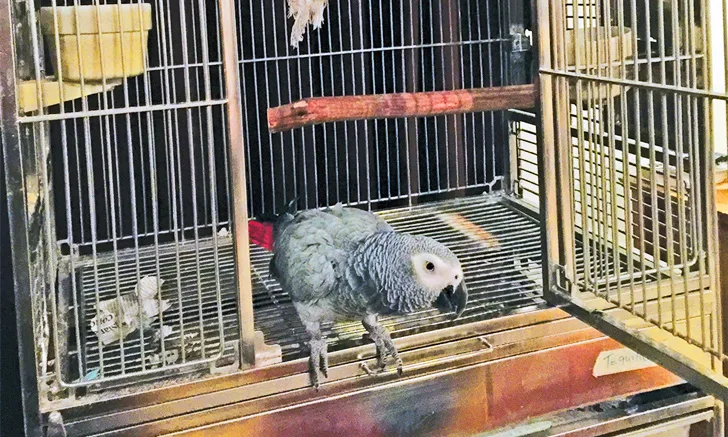Environmental Enrichment for Pet Psittacines
Gwen B. Flinchum, DVM, DABVP (Avian), All Bird Clinic of the Palm Beaches, Greenacres, Florida

Birds (particularly psittacines) in captivity with no mental or physical stimulation may exhibit behavior patterns not shown in their biologically natural environment.1,2 Such patterns may include feather destruction3,4 and repetitive functionless activities (eg, pacing, cage circling, wire chewing).5 Environmental enrichment provides stimulation and has been shown to decrease undesirable behaviors in these pets.4-7
Natural Psittacine Behavior
Environmental enrichment for pet birds involves modification of a caged environment to allow expression of natural behaviors (Figure 1).6 Natural behaviors generally include foraging, social interaction, feather care, and nesting. In many species of wild parrots, foraging and feeding represent most (>50%) daily activities.8 Similarly, other birds (eg, wild quail, jungle fowl) live in small social groups and devote much of their day to scratching, foraging, and roosting. They also perform sequences of behavior such as dust bathing and prelaying nesting.
Figure 1 Hyacinth macaw manipulating an environmental enrichment baffle cage

Related Article: The Avian Physical Examination
Psittacines deprived of their natural behavior or housed in impoverished environments often develop abnormal, repetitive behaviors (ie, stereotypies).5 Stereotypies can be oral (eg, repetitive food manipulation with the beak, chewing movements with no food in the beak) or locomotor (eg, pacing, cage corner flips).9 Studies suggest that oral stereotypies are related to limited foraging opportunities, whereas locomotor stereotypies result from lack of space or impoverished environments.5 Stereotypies have been observed in commercial poultry flocks in the form of aggressive head pecking, feather pecking, food wastage, and increased fearfulness.10-12
Treatment At A Glance
Enrichment Strategies & Implementation
Environmental enrichment has been useful in managing stereotypies, fearfulness, and stress in captive psittacines.
Because foraging constitutes a large portion of a bird’s normal activity in the wild, deprivation can result in destructive behavior, aggression, or self-mutilation.
Foraging Enrichment
Foraging enrichment involves strategic placement of food. Food can be scattered throughout an environment or hidden in an object so that the bird must figure out how to access the food. Because foraging constitutes a large portion of a bird’s normal activity in the wild, deprivation can result in destructive behavior, aggression, or self-mutilation.7,13 Therefore, it is recommended that bird owners incorporate foraging strategies into the bird’s daily activities. Foraging toys can be created by wrapping food treats in pieces of paper, putting nuts in small paper boxes, wrapping twine around unshelled nuts, putting treats in a closed paper cup, or stuffing paper or treats in PVC pipes. Several commercial companies produce puzzle-type foraging toys that can be hung on a bird’s cage and replenished with materials as needed (see Resources).
Related Article: Feather Picking in Pet Parrots
Figure 2 African grey with environmental enrichment toys in a cage

Physical Enrichment
Physical enrichment involves modification of a bird’s physical environment to encourage normal activity. Deprivation of physical enrichment often leads to aggression, pacing, and feather destruction. These can be prevented with the inclusion of cage toys (eg, chew toys made of paper or straw, ladders, puzzle toys, perches; Figure 2), which enable the bird to fulfill natural instincts of chewing, climbing, playing, and curiosity. Frequent rotation of various toys encourages continued interest and activity. Any items being considered for physical enrichment should be inspected and deemed safe before use. Physical enrichment may also include opportunities for increased physical activity, such as providing a safe area for supervised flight.
Social Enrichment
Social enrichment allows bird-to-bird and/or bird-to-human interaction and can be indirect (ie, birds see or hear others) or direct (ie, birds are paired or able to mingle in a specialized play area). Social compatibility can be key in the success of social enrichment, as some birds may exhibit aggressive behavior. Studies have shown that socially housed animals have fewer stereotypic behaviors than those individually housed.14 Social enrichment is perhaps most important for young, developing birds.
Related Article: Exotic Pet Ownership: Responsible or Not?
Conclusion
Abnormal behaviors are common in pet psittacines. Although behavior analysis and behavior modification may help reduce some forms of fear- or stress-related responses, environmental enrichment has proven to be an important component in the mental and physical well-being of caged birds.
FIND MORE ...